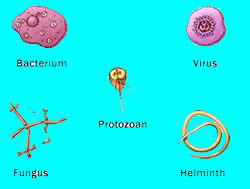Difference between Bacteria and Germs
Key Difference: Bacteria are single celled micro-organisms that belong to the group of Prokaryotics. A Germ is a non medical term that is used to refer to a microorganism, especially the one that can cause any disease. Example of Germs includes amoeba, fungus, bacteria, richetchia, virus, and so many others. Thus, some Bacteria are also known as Germs.
.jpg) Germs can be described as the micro-organisms that are harmful and cause sickness, infection and disease. These germs are basically pathogens; “Patho” is Greek word for suffering, and “gen” is a suffix meaning producer.” Germs can be classified into four major groups: Virus, Bacteria, Fungi, and Parasites.
Germs can be described as the micro-organisms that are harmful and cause sickness, infection and disease. These germs are basically pathogens; “Patho” is Greek word for suffering, and “gen” is a suffix meaning producer.” Germs can be classified into four major groups: Virus, Bacteria, Fungi, and Parasites.

Some Bacteria also cause sickness, and thus are considered to be Germs. For example MRSA (meticillin-resistant Staphylococcus aureus) is a Bacterium that causes an infection, and therefore is termed as a Germ.
Some of the important characteristics of Bacteria and Germs are listed below:-
|
|
Bacteria |
Germs |
|
Definition |
Bacteria are single celled microorganisms and belong to the group of Prokaryotics. |
Germs are single celled or multiple celled microorganisms that are harmful and cause sickness, infection and disease. |
|
Useful |
Some bacteria are useful. |
All cause some or the other kind of harm. |
|
Example |
Help in stimulate digestion of food and absorption of nutrients. |
Bacillus anthracis is the name of a bacterial germ that causes anthrax. |
|
Reproduction |
Some can reproduce on their own. |
Some can reproduce on their own, and some requires a host cell. |
|
Types
|
Based on the morphology, DNA sequencing, conditions required and biochemistry, Bacteria are classified into 28 different bacterial phyla: Acidobacteria, Actinobacteria, Aquificae, Bacteroidetes, Caldiserica, Chlamydiae, Chlorobi, Chloroflexi, Chrysiogenetes, Cyanobacteria, Deferribacteres, Deinococcus-Thermus, Dictyoglomi, Elusimicrobia, Fibrobacteres, Firmicutes, Fusobacteria, Gemmatimonadetes, Lentisphaerae, Nitrospira, Planctomycetes, Proteobacteria, Spirochaetes, Synergistetes, Tenericutes, Thermodesulfobacteria, Thermotogae, Verrucomicrobia |
There are four major types of germs: Bacteria, Viruses, Fungi and Protozoa (Many people exclude viruses from the group as they are not considered living.) |
|
Transmission |
Can spread by Direct/Indirect Contact, by droplet transmission and by environmental sources. |
Most germs are spread through the air when someone sneezes, coughs, or even when they breathe. Germs can also spread via sweat, blood, and saliva. |
|
Cause |
Some bacteria, such as pneumococcus, which is also called as Streptococcus pneumoniae, always causes illness if it gets into the body. |
Bacteria: Salmonella and E. coli bacteria can cause food poisoning. Viruses: Rhinoviruses can cause colds. Herpes simplex causes cold sores. Influenza can cause the flu. Fungi: Trichophyton (a dermatophyte) can cause Athlete's Foot. Parasites: Giardia can cause diarrhea. |
|
Treatment |
Most bacterial infections can be cured by antibiotic drugs. Penicillin, the first antibiotic, is still used to treat some infections. |
Treatment depends upon the type of germs. For example, Bacteria may be cured by antibiotic, whereas germs like virus may need a vaccine. |
Image Courtesy: assignmentpoint.com, riversideonline.com









Add new comment